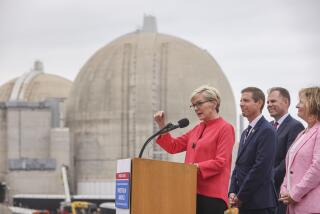Reagan OKs Atom Smasher to Keep U.S. Physics No. 1 : Site Near Stockton a Possibility
- Share via
WASHINGTON — President Reagan will seek funds to build the $6-billion “supercollider” atom smasher sought for years by the nation’s physicists to investigate the scientific secrets of matter, Energy Secretary John S. Herrington announced today.
The machine, which would be a ring 52 miles in circumference, would dwarf every atom smasher in existence and, scientists hope, reveal the innermost secrets of matter.
“In high-energy physics, the development of the supercollider is the equivalent of putting a man on the moon,” Herrington told a news conference.
He said the government will try to share the cost as much as possible with other nations, private industry and state and local governments wherever the nuclear particle accelerator is located. No site has been picked and there is no front-runner, he added.
45 States Interested
Forty-five states, including California, have expressed interest in the project. A site near Stockton has already been chosen as California’s entry in the competition. The state that wins will become a mecca for the world’s scientists.
Proponents of the machine say it is essential if the United States hopes to maintain its lead in physics research. They say that if the European consortium operating the CERN machine at Geneva goes ahead with plans to build a much smaller nuclear particle accelerator and the United States does not, the world’s researchers almost certainly will flock to Europe.
The Office of Management and Budget in the past has questioned the large expenditure necessary to build the machine. The largest scientific instrument ever contemplated, it is also the most expensive--a problem in the Gramm-Rudman era.
Herrington decided to support the supercollider shortly before his department’s budget request for fiscal 1988 was completed. The request contains no funds for the machine, but Herrington said the $60 million needed for 1988 activities could be found easily in other projects without seeking new funds.
Would Involve 3,000 Jobs
However, requests for new money would be necessary in subsequent years.
The Energy Department has already been spending about $20 million a year on planning the supercollider.
The project would involve 3,000 jobs and an operating budget of about $200 million a year.
The supercollider would be placed in an oval tunnel with a circumference of about 52 miles about 20 feet underground.
Powerful magnets would force counter-rotating beams of protons, one of the naturally occurring subatomic particles that make up the building blocks of all matter, to smash into each other with an energy of 40 trillion electron-volts, more than 20 times the maximum energy of the most powerful existing accelerator and three times the planned collision energy of the new CERN machine.
‘Big Bang’ Density
The collisions would concentrate into a small region of space the energy density that some scientists believe must have existed at the moment of the “big bang” that created the universe.
From the collisions could come particles predicted by exotic theories of the origin of matter. Not all the energy of the collision is available to create mass, but particles of more than a trillion electron-volts mass equivalent could be created, scientists say.
The magnets would draw so much electrical current that they would be cooled below the point at which electrical resistance ceases, that is, into the “superconducting” region. For this reason, the accelerator is sometimes called the “superconducting supercollider.”






